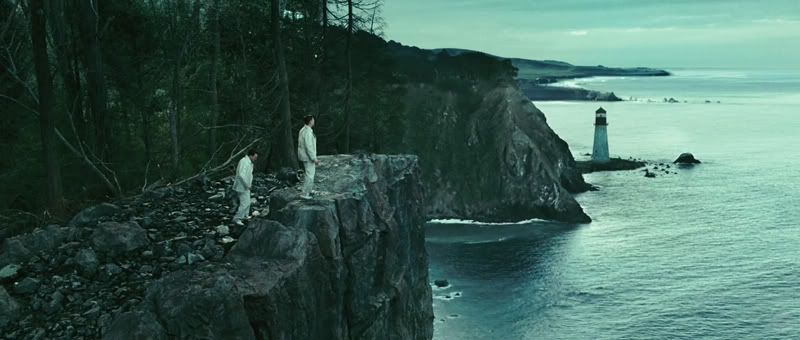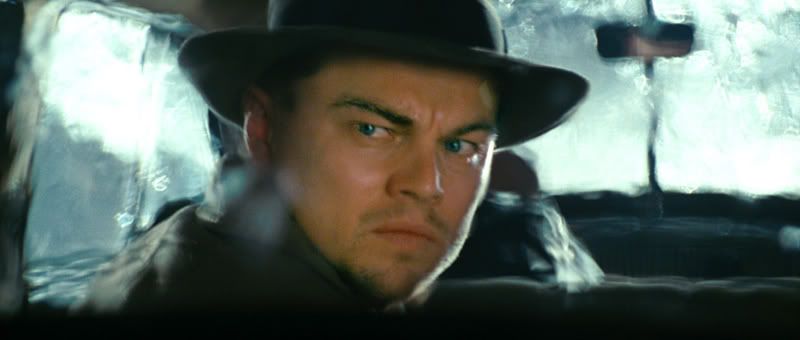
Martin Scorsese's latest film, Shutter Island, is a stylish, artfully made work that establishes a powerful atmosphere of dread and despair right from its opening minutes, as a ship emerges from a thick gray fog and U.S. Marshal Teddy Daniels (Leonardo DiCaprio) sweats and shakes while staring into the mirror. Together with his new partner Chuck (Mark Ruffalo), they're heading to the foreboding, forbidding Shutter Island, a combination prison and mental hospital designed to hold only the most violent and dangerous mentally ill patients. One of these patients has escaped, and Daniels' investigation of this mysterious place will be a challenge to his own sanity. Scorsese's film is an odd, unsettling, potent concoction, at least for most of its length, even if it's painfully obvious just where it's heading long before it ever gets there — and even if its inevitable final act is disappointing in its predictability.
There is a nicely suggestive idea contained in this final act, nonetheless — and if it's not obvious by now, it's impossible to talk about this film without talking about its ending — and Scorsese does manage to make this resolution heart-wrenching and affecting even as it's also trite and formulaic. There have been countless films that revolved around the kind of pat reversal that Scorsese (working from a source novel by Dennis Lehane) tries to pull off here: see, the marshal was really a patient all along, and the film's whole convoluted plot, with all its conspiracies and weird details, was an elaborate attempt by the hospital's staff to shock Teddy out of his delusions. Of course, this could only fail to be obvious to those who have never seen a movie like this before, to those unfamiliar with the generic conventions that control this kind of movie. The thing is, no matter how familiar this territory is, Scorsese makes it a thrilling ride to traverse it once again. Right from the very first scene, it's obvious that something's up: something seems subtly off about the initial interactions between Chuck and Teddy, and it's not just the way Scorsese's camera gently directs attention to mundane acts like the sharing of cigarettes. We feel that these small gestures, these details, will be important later; Scorsese's visual cues suggest a mystery that revolves around the very basic precepts of this situation. It's possible that some may even guess, already, where this is all heading; it occurred to me, at least.
It almost doesn't even matter, though, as Scorsese makes the film's introductory scenes so compelling that any explanation seems unnecessary. There's an air of unreality to these opening scenes that never quite goes away. The sky behind Teddy and Chuck is somehow too dramatic, too beautiful with its thick gray clouds and the roiling water. Few commentators have failed to note the influence of British filmmakers Powell and Pressburger on this film, but it goes beyond the post-World War II setting or the handful of dizzying overhead shots looking down a cliff, directly referencing Black Narcissus. The stylization, the studio-bound aesthetic of Powell and Pressburger's lurid fantasies, lingers over this film even though Scorsese's shooting on location. Shutter Island, as a place, is a fusion of movie archetypes, a perfect genre location, all dark corridors dripping with water, flickering lights everywhere, barbed wire, a decrepit old cemetery, a lighthouse strangely guarded at all hours, where terrible experiments are rumored to take place. This is a movie-movie, a movie that's constantly reminding one of other movies, that revels in its genre conventions and self-consciously keeps pointing them out. That's certainly apparent in Teddy's troubling visions of Andrew Laeddis (Elias Koteas), who he believes is a patient here. Laeddis was the man who Teddy blames for the fire that killed his wife Dolores (Michelle Williams), but Laeddis is such a sinister, over-the-top movie monster — with a scar across his face, a milky white eye and a melodramatic leer — that it's impossible to believe he's a real person. It's obvious from the start that he's a mental projection, a way for Teddy to avoid the real truth, whatever it is, about his wife and his past. Koteas plays this monstrous character with clear delight, relishing the melodramatics, playing him like Scorsese's Travis Bickle a few years older and even further gone, twitching and grinning with his deformed face.

This is the kind of pleasure Shutter Island offers, and it's not an incidental pleasure by any means. Scorsese fully adapts to the conventions of the horror genre here, offering up some rather startling jump scares, like the half-naked inmate who leaps out of a dark passageway to scream "tag, you're it" and then races back off into the darkness. The fun here isn't necessarily in the content but in the execution, the way Scorsese continually does exactly what one expects but puts his own idiosyncratic twist on it. The atmosphere of the island, almost constantly overcast, with stormy weather always looming overhead, is one of slowly creeping dread. Scorsese further enhances this mood by inserting Teddy's internality into the film, a mix of visions, dreams and memories: of his wife, of the woman he's supposed to be finding on the island (played at various times by Patricia Clarkson or Emily Mortimer), and especially of his past as one of the soldiers who first walked into Dachau at the close of World War II. The film is located at this particular historical moment, in 1954, with the nightmare of the Holocaust not so distant, and Scorsese does a good job of capturing the paranoia and the terror generated by this travesty: most particularly, the fear of science as a monstrous corrupter, responsible for both the hydrogen bomb and the devilish human experiments of Dachau and Auschwitz. This fear informs Teddy's own paranoia, his solid belief that terrible experiments are being performed on the patients on Shutter Island. His rantings, increasingly unhinged throughout the film, draw from the fear of Nazism's anti-human sensibility spreading domestically, and from the kind of distrust of human decency that things like the Milgram experiments tended to confirm.
Some of that aura of dread comes, too, from Scorsese's soundtrack selections. He's assembled a compelling, complex soundtrack in which the music, frequently grating and eerie, seems to emanate from the harsh terrain of the island itself. Challenging classical and modernist music by John Cage, Gustav Mahler, Morton Feldman, György Ligeti, Krzysztof Penderecki and John Adams is omnipresent here, solitary notes and clusters of notes hovering in the still, damp air, occasionally interrupted by the piercing screams of the inmates. Scorsese's use of sound here is as compelling, as sensitive, as his more familiar pop music soundtracks in Mean Streets or Goodfellas. The music is so dense, so intense in its effect, that the moments of silence, the moments where the music cuts away to reveal a profound and empty quiet, hit as though all the air had been suddenly sucked away, leaving behind this awful vacuum. The complexity and eerie beauty of this soundtrack is often matched by the quality of Scorsese's images, which have a kind of processed grandeur that one associates with the Technicolor era, another reason the Powell/Pressburger comparisons are so salient. At one point, flickering flames slash up across the screen like fragments of Brakhagian light and color, as though Scorsese were superimposing this kind of experimental light study atop his images, playing across the faces of the actors. Even Scorsese's judicious application of CGI is affecting, and eerie: a shot where Teddy embraces Dolores in a vision, only to have her turn to ash and burn away, is devastating. The ash, often raining down around Teddy in the nightmare visions that haunt him, represents both the fire that killed his wife, and the human ashes that often rained from the smokestacks of the death camps when the ovens were running.
As powerful as the film often is, its final act is clumsy and uneven, delivering exactly the expected payoff and relegating way too much time to the hospital psychiatrist Dr. Cawley (Ben Kingsley) laboriously explaining the whole thing. If the rest of the film is affecting and off-kilter, packed with compelling imagery, the finale switches gears for a succession of talking heads spelling out the entire plot. The film is a mood piece where the mood is abruptly disrupted in the last act. Nevertheless, even here Scorsese crafts some stunning sequences, particularly an absolutely horrifying flashback in which Teddy finally remembers, or understands, what actually happened to his wife. Still, there's an unavoidable aura of disappointment throughout the final scenes, a sense that Scorsese had abandoned the film's visual richness and imagination for a rote series of psychological explanations and diagrams, a nod to Psycho with Kingsley in the role as the psychologist profiler, diagramming and lecturing about the film's plot. If the rest of the film provides evidence of Scorsese's visual and emotional deftness, this ending perhaps suggests the limits of his imagination.







0Awesome Comments!